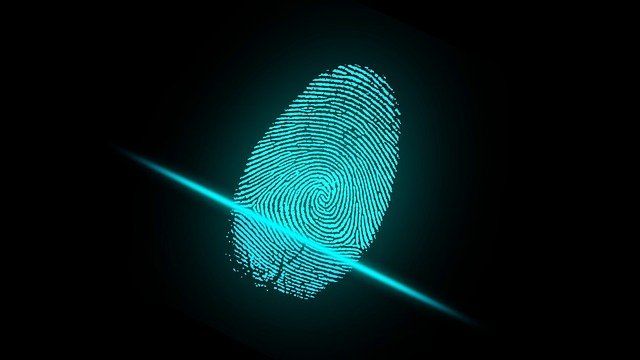Almost every time that we touch something, we leave something behind. Yes, you guessed it right, we leave behind our fingerprints. Every individual has a unique set of fingerprints. Even identical twins do not have identical fingerprints. If you look closely, you will see that you have fingerprints not only on your fingers but also on your palms, your toes, and the soles of your feet. However, since most often we touch objects with our fingers we take records of our fingers.
How are fingerprints developed?
Fingerprint patterns consist of raised patterns called dermal ridges. The development of fingerprint patters begins when the baby is still in its mother’s womb. When it is only 3 months old in the womb, the baby has smooth skin, then something interesting happens.
The outer most layer of skin called the basal layers starts developing faster than the inner layers called the dermis and the epidermis. If this continued to happen the outer layer would eventually form a loose overhang over the inner layers. What does indeed happen is that the basal layer starts bucking and folding up slowly forming the fingerprint like patterns.
The movement of the foetus inside the womb also influences the patterns that are formed. When the tiny fingers experience pressure while moving and touching the womb, the fingerprint patterns are influenced in a particular way. The conditions inside a womb are not constant and no two fetuses move in the same way.
Q1. Can you explain how identical twins have identical genes but not identical fingerprints? (Answer at the end of the article)
By the end of 6 months inside the womb, the fingerprint patterns become fixed and do not change until you die.
Types of fingerprint patterns
Let us take a look at some of the different kinds of fingerprint patterns that are formed, the most common of which are loops, whorls and arches.

Loops: Loops are fingerprint patterns that form a loop shape. If the loop is facing towards the thumb or the radial bones, it is called a radial loop and if the loop faces towards the pinky finger or the ulnar bone, it is called as an ulnar loop. 60 % of all fingerprint patterns are loops.
Whorls: Whorls are fingerprint patterns that make at least one full circle or spiral pattern. The four common types are plain which looks concentric circles, central pocket loop which a loop with a whorl at the end, double loop consist of two loops that create an S-like pattern, and accidental loop which are irregular shaped. Around 35 % of all fingerprint patterns are whorls.
Arches: Arches are the rarest types of fingerprint patterns and look like mountains or ocean waves. Plain arches and tented arches are the common types and tented arches rise higher and have a sharper point. They make up only 5% of all patterns.
| Type | Loop | Whorl | Arches |
| Shape | Loop shaped | Complete circle or spiral | Mountain or ocean wave shaped |
| Frequency | 60 % | 35% | 5% |
| Types | Radial
Ulnar |
Plain
Central Pocket Loop Double loop Accidental loop |
Plain
Tented |
Fingerprint analysis is used in various places today.
Q2. Can you name a few places where fingerprint scans are used? (Answer at the end of the article)
Fingerprints in Forensics
One of the very important places that fingerprints are of value are at a crime scene. There are two kinds of fingerprints that can be found. One, that are readily visible, such as the ones that are formed in a blood stain, or on dirt, glass, plastic etc and they are called patent prints. The other kind of prints that are found are called latent prints and are not readily visible and they require the use of special fingerprint detection powders to be seen.
Patent Prints
Patent prints are easily collected from a crime scene. The detective will simply take a clear photograph of the print. Usually, a scale will be used in the photograph to ensure the correct dimensions of the fingerprints is taken.
Latent Prints
Latent prints are more difficult to collect. The detective has to dust potential surfaces with fingerprint powder. Fingerprint powders can contain aluminum flakes, black ferric oxide, lampblack, graphite charcoal and can also contain lead, mercury, cadmium, copper, slicing, titanium and bismuth. Once they are found, they are photographed, and them lifted from the surface using clear tape, and placed on a card and preserved. One disadvantage of using this method, is that once the powder is applied, it contaminates any other evidence that could be there, for example, one would not be able to perform DNA analysis on a sample that may be found later as it may have been contaminated with the fingerprint powder.
To avoid this, detectives can use an Alternate Light Source (ALS) that are small devises like torches that emit required wavelength of light. Depending on the surface being examined the wavelength of the light would be changed. The other alternative method that detectives use is fuming with cyanoacrylate. Cyanoacrylate is a component of super glue and will stick to surfaced with fingerprints on them allowing them to become visible. If paper sheets are to be examined, a chemical called ninhydrin can be sprayed that will make any invisible fingerprints appear purple coloured.
As a detective, you will always have tough choices to make. Should you pick up DNA fragments? Or should you look for fingerprints? Choosing one of the options will most likely destroy your ability to gather evidence through the option. What if you choose to use DNA, but it belongs to identical twins, then you wouldn’t be able to distinguish between whom the DNA belonged to. What if you choose to collect fingerprints, but they turn out to be 25 days old? Fingerprints last a long time, and you cannot convict a person just over that. So, it all comes down to various other factors as well.
Ans 1: Identical twins occupy different regions of the womb, move around differently and their fingers face different pressures, which leads to formation of unique fingerprint patterns. Here, though they share the same genes, the environment also plays a role and influences their development.
Ans 2: Fingerprint scanners are used to issue some official documents, they are also used to open locks, phones, etc, they are used for attendance marking in some institutions.
References
To, A. S. G. Fingerprint Analysis.
https://sciencing.com/ingredients-fingerprinting-powder-8592401.html
https://healthfully.com/287440-the-development-of-fingerprints-in-babies.html
Read more Articles from Life Sciences
1. Read about the Start Your Own Fruit Fly Culture at Home
2. Read about the Did You Just Spot a Cheetah a Leopard and a Jaguar
3. Read about the The Secret Lives of Tardigrades
4. Read about the Chlorophyll and Haemoglobin – An Unlikely Connection
5. Read about the What is the True Colour of the Coronavirus?
6. Read about the 7 Fascinating Facts About Fruit Flies
About Author
Saunri Dhodi Lobo is pursuing M.Sc in Life Sciences with specialization in Neurobiology. Her interests include writing poetry, going for nature walks and swimming. Currently she is involved in research on Alzheimer’s Disease in fruit flies.
Read all Articles by Saunri Dhodi Lobo
Photos, Vector Graphics & Illustrations Credits
By Ilyabasharov – Own work, CC BY-SA 4.0, https://commons.wikimedia.org/w/index.php?curid=85094125
By ViktorDFC – Own work, CC BY-SA 4.0, https://commons.wikimedia.org/w/index.php?curid=72896199

